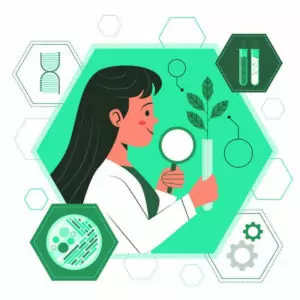Variation, a fundamental concept in biology, pertains to the differences we observe among members of the same species or among different species. From subtle differences in physical appearance to differences in genetic makeup, the spectrum of variation is wide and diverse. This article delves into the essence of variation in biology and how it plays an integral role in evolution, genetics, and the overall continuity of life.

✅ AI Essay Writer ✅ AI Detector ✅ Plagchecker ✅ Paraphraser
✅ Summarizer ✅ Citation Generator
Genetic Variation
At the heart of variation is genetics. Genetic variation refers to the differences in the genetic makeup or DNA sequence between individuals within a population. These genetic differences arise due to changes in the chromosomes, where our genetic information is stored. Often, these genetic variations result in genotypic variations and phenotypic variations.
- Genotypic Variation: Differences in the genetic makeup or DNA sequence between individuals. These variations are often influenced by both hereditary alteration and environmental conditions.
- Phenotypic Variation: Differences in the physical or observable traits of an organism, such as hair color, height, or behavior. It’s essential to note that while phenotypic variation can be influenced by genotypic differences, it can also be influenced by environmental factors without any change in the DNA sequence.
Homology vs. Analogy
Two key concepts that emerge while studying variation in biology are homology and analogy:
- Homology: Refers to the similarity in structure, physiology, or development due to a common evolutionary ancestor. For instance, the structure of the forelimbs in humans, bats, and whales might differ in function but they share a similar bone structure, signifying a shared evolutionary origin.
- Analogy (Analogical Structures): Refers to structures that have a functional similarity but do not share a common evolutionary origin. They arise due to similar environmental pressures leading to evolutionary modification. For example, the wings of bats (mammals) and birds might serve the same function but they don’t share a common early mammalian ancestor in terms of wing development.
Impact of Environmental Factors
Environmental factors play a significant role in introducing variation within a population. These factors, ranging from temperature, availability of food, to seasonal variations, can influence both the genotypic and phenotypic variations. Environmental conditions can lead to morphological differences among organisms of the same species inhabiting different habitats. For instance, plants of the same species might develop different vegetation structures when subjected to different environmental conditions.
Polymorphic Variation
Polymorphism in biology refers to the occurrence of multiple forms or types of individuals among the members of a single species. A classic example is how blood groups vary among humans. These variations often fall into well-defined classes. Polymorphic variation is crucial for evolution as it provides a reservoir of variations that nature can select for or against, depending on the changing environmental conditions.
Evolutionary Traits and Chromosomes
Variation is the cornerstone for evolution. Without genetic variation, there would be no material for natural selection to act upon. It’s the genetic differences and potentials housed within our chromosomes that lead to the emergence of evolutionary traits. These traits, over generations, might offer a survival advantage or disadvantage, leading to evolutionary change.
Conclusion
Variation in biology, driven by both genetic factors and environmental influences, ensures that life on Earth is diverse and adaptable. From genetic differences hidden in our chromosomes to visible phenotypic changes influenced by the environment, variations enrich the tapestry of life, driving evolution and ensuring the survival of species in the ever-changing world.
FAQ
Follow us on Reddit for more insights and updates.





Comments (0)
Welcome to A*Help comments!
We’re all about debate and discussion at A*Help.
We value the diverse opinions of users, so you may find points of view that you don’t agree with. And that’s cool. However, there are certain things we’re not OK with: attempts to manipulate our data in any way, for example, or the posting of discriminative, offensive, hateful, or disparaging material.